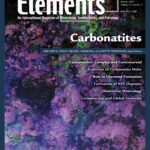Organic Biomarkers, April 2022, Vol. 18, No. 2
$20.00
Biomarkers are molecular fossils that are preserved in a wide range of environmental archives (e.g.
Organic Biomarkers
April 2022, Vol. 18, No. 2
Biomarkers are molecular fossils that are preserved in a wide range of environmental archives (e.g., soils, sediments, sedimentary rocks, and petroleum systems). This issue introduces biomarkers and their compound-specific stable isotope compositions to study fundamental biogeochemical processes and their application as proxies for environmental and climate reconstructions. Molecular biosignatures can be used to study the evolution of life, transitions in ocean plankton over time, the microbiota of extreme environments such as hydrothermal systems and the deep crustal biosphere, and to search for signs of life beyond Earth. Important new discoveries are typically the result of the development and deployment of improved instrumental techniques, multidisciplinary research approaches, and the combination of organic biogeochemistry with the new tools of molecular biology.
Why You’ll Love Elements Magazine:
- Expert Contributors: Articles written by renowned researchers in the field of geoscience.
- Engaging Content: Join a community of readers who are passionate about Elements.
- Exceptional Quality: Each issue is printed on high-quality paper with stunning visuals and detailed illustrations that bring complex scientific concepts to life.
Order your copy of the April 2022 issue of Elements magazine today and explore organic biomarkers.
Related products
-
Phosphates And Global Sustainability, April 2008, Vol. 4, No. 2
$20.00Phosphorus is a unique element: it is essential to the existence of all living forms, and as such controls biological productivity in many terrestrial and marine environments; but when in excess, it leads to uncontrollable biological growth and water-quality problems. This has become a common environmental issue, resulting from our careless use of phosphorus in agriculture, yet phosphate ore deposits, from which fertilizers are produced, are a finite natural resource.
-
Medical Mineralogy And Geochemistry, December 2007, Vol. 3, No. 6
$20.00Medical mineralogy and geochemistry is an emergent, highly interdisciplinary field concerned with both normal and pathological interactions between minerals or amorphous inorganic solids and biomolecules or cells within the human body, and the transport and fate of prions and protein toxins in the soil environment. Prior research has, appropriately, focused on the complex genetic and molecular biological aspects, but there is a growing recognition of the vital need for understanding the surface and bulk properties and reactivities, especially at the challenging nanoscale characteristic of biomacromolecules and biominerals.
-
Large Igneous Provinces: Origin And Environmental Consequences, December 2005, Vol. 1, No. 5
$20.00Large igneous provinces record major outpourings of igneous rocks, both on the continents and in ocean basins. Their origin is still vigorously disputed, with models invoking mantle plumes, thermal effects of the lithosphere, and meteorite impacts.






